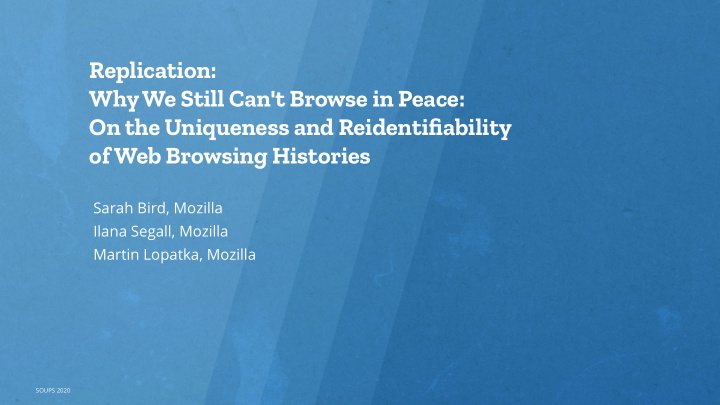



Replication: Why We Still Can't Browse in Peace: On the Uniqueness and Reidentifiability of Web Browsing Histories Sarah Bird, Mozilla Ilana Segall, Mozilla Martin Lopatka, Mozilla SOUPS 2020
Original Paper Browsing history - the set of domains you have visited - is highly unique Why Johnny Can't Browse in and could be used as a tracking vector. Peace: On the Uniqueness of Web Browsing History Patterns Why replicate: The web and browsing has evolved: ● Olejnik, Castelluccia, user generated content and core and Janc platforms 5th Workshop on Hot Topics Tracking ecosystem has grown and ● in Privacy Enhancing consolidated Technologies We can collect more detailed data to ● (Hot-PETS 2012) answer questions about reidentifiability raised by original paper
Background & Definitions 52,000 Firefox opt-in users 2 weeks of data collection Types of profile ● 35 million site visits All observed domains ○ Predefined list of domains - Trexa (Tranco + Alexa) 660,000 distinct domains ○ Categories ○ Profile - a list of x that a user visited ● Profile size - how many x did a user have in total? ● Length of subvector - how many x are we considering? ●
Replication We replicate the core findings of Olejnik et al. A large proportion of profiles are unique. This holds even for small profiles e.g. 50 domains.
Extension We move beyond profile stability to measure a reidentification rate. Jaccard distance - degree of overlap between two sets. (a) For each wk1 profile compute the Jaccard distance to all wk2 profiles (b) pick the profile with the lowest Jaccard distance (c) If wk1 and wk2 users are the same, it is a match. Reidentifiability metric: % of users correctly matched
Baseline reidentifiability n = 19,263 users with profile size > 50
Scalability A 10x reduction in the number of users increases reidentification rate by 10%. Monte Carlo simulation on users with profile >50, sampling between 1 and 19,263 users, 55,000 times.
Profile Size ~80% for profile size >150 Compute reidentifiability rates for equally sized groups of users (n=1,766) with different profile sizes. Reidentifiability does not change dramatically between all domains and Trexa list. ~50% for profile size ~50
Third-parties Alphabet and Facebook have close to maximum Use complete theoretical request-response data to reidentifiability rates. identify actual exposure to third parties (grouped by entity e.g. Alphabet parent company of Google and others). A large number of third parties have sufficient presence for meaningful reidentification rates
Discussion! Sarah Bird, Mozilla* Ilana Segall, Mozilla Martin Lopatka, Mozilla * Corresponding author - sbird@mozilla.com SOUPS 2020
Recommend
More recommend